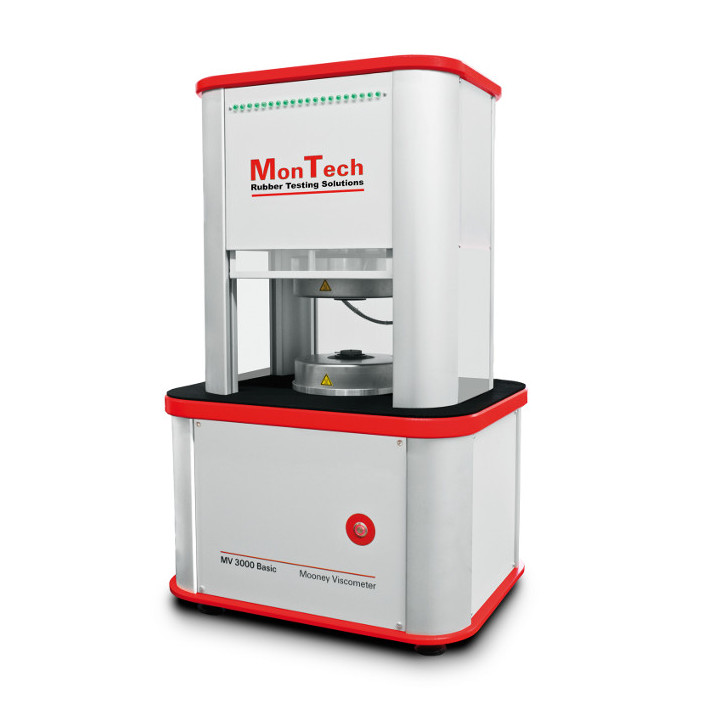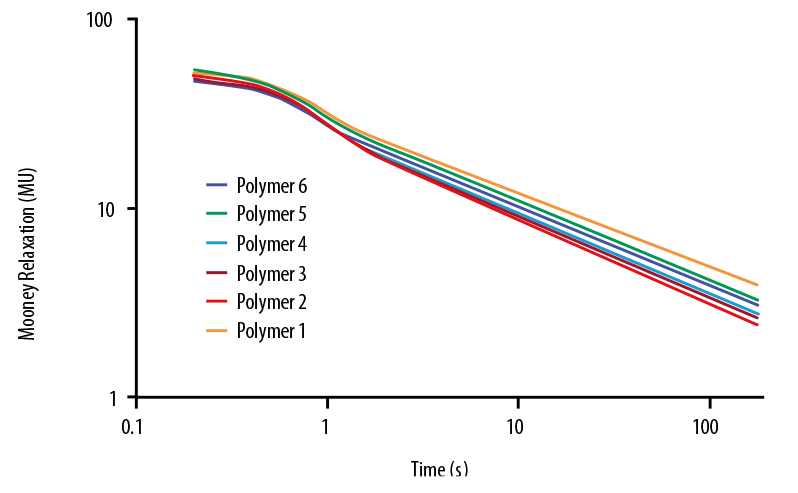MV 3000 Basic Mooney Viscometer
Mooney viscosity, Mooney scorch, and stress relaxation values are easy to attain with MonTech’s entry-level Mooney viscometer.

Advanced Features & Applications
- Fanless aerospace grade aluminum and stainless-steel framing for tough production environments or laboratory settings
- Direct drive motor
- Two rotations per minute
- Integrated self-diagnostic instrument control software with condition monitoring routines
- Pre-programmed test parameters
- Integrated multi-color LED status bar
- Includes MonControl LIMS instrument management software
- Host-system linkable for easy integration into any laboratory
- Lower radial V-Groove die – accommodates large or small serrated rotor
- Equipped with industry standard programmable logic controller for reliable operation and sampling rate
View Applications
- Mooney Viscosity
The Mooney Viscosity test is the most popular test method for characterizing polymers and uncured rubber materials. Defined by international standards, the sample material is preheated for a defined period in a closed die cavity, then sheared by the embedded rotor at a constant rate. The Mooney Viscosity is recorded and data is automatically calculated at predefined time and viscosity points.
MonTech Mooney Viscometers offer superior precision and repeatability, providing the user with reliable data and making it easy to differentiate between different types and grades of polymers in order to ensure a high processing consistency.

- Mooney Stress Relaxation
While Mooney Viscosity testing only provides information about the flow/viscosity of polymers and rubber compounds, stress relaxation testing assesses elastic material behavior.
Once the Mooney Viscosity test is completed, the rotor is stopped within 5 milliseconds and the torque decay is observed and recorded. Once the stress relaxation is completed, the slope-intercept and regression coefficient are calculated, providing excellent correlations in reference to polymer branching and processing.

- Mooney Scorch
Mooney Scorch tests determine onset of vulcanization (also known as scorching behavior) in rubber compounds. This provides essential data for designing/controlling production processes and verifying material consistency.
Every MonTech Mooney Viscometer offers full Mooney Scorch and Delta Mooney testing capabilities. These capabilities feature a comprehensive selection of data points such as initial Mooney viscosity, minimum viscosity, scorch times and scorch viscosities.


Mooney Viscometer Test Chamber
Technical Specifications
Standards | ISO 289:2018 |
Die Configuration / Rotor | According to international standards |
Force Measurement | In-line torque transducer |
Closing Force | 11.5 kN |
Rotor Speed | 2.00 turns per minute (0.21 Radians / second) |
Rotor Shaft Seal | Standard or long life seals available |
Stress Relaxation | According to ISO 289:2018, DIN 53523 Part 4 |
Torque Range | 0.01 to 230 MU |
Sample Volume | Two specimens having a combined volume of 25 cm3 |
Temperature Control System | Ambient to 232 °C, precision +/-0.03°C, digital, microprocessor controlled |
Temperature Check System | Recordings of the temperature gradient on the screen, |
Calibration | Fully automatic by built-in calibration weights, software-guided |
Measured Data | Mooney - value (MU) |
Data Interface | Ethernet (10/100 MBit), USB (int.), CF card (int.), RS232 (opt.) |
Data Points | Over 3500 data points available, including: |
Pneumatics | min. 4.5 Bar / 60 psi |
Electrical | 100-120 V, 8 Amps or 200-240 V, 5 Amps, 47-63 Hz, Single phase |
Dimensions (H x W x D) | 36.6 in x 19.7 in x 22.8 in (93 cm x 58 cm x 50 cm) |
Instrument Options | - Instrument control panel with 5" trouchscreen display and printer |
Advanced Modules
- Pneumatic Cooling System
- Instrument Control Panel
Pneumatic Cooling System
This pneumatic air cooling system cools both dies separately using independent PID-controllers, rapidly cooling the instrument from higher to lower testing temperatures. When using non-Isothermal and RPA operation modes this system enables cooling at any point during the test.
- • Allows test sequences to follow precise cooling ramps and steps
- • Conducts friction heat away from the sample when testing at high shear rates
- • Reduces non-productive time of the instrument and operator by shortening stabilization time
- • Air lines have quick connects at each platen, and exhaust through the platen assemblies
- • Air is supplied by an independent regulator on the back of the machine
Instrument Control Panel
The 5“ Color-Touchscreen allows the machine to be operated from a remote computer or completely standalone for simple quality control testing.
